Charles E W Bean, Diaries, AWM38 3DRL 606/282/1 - 1918 - 1940 - Part 2
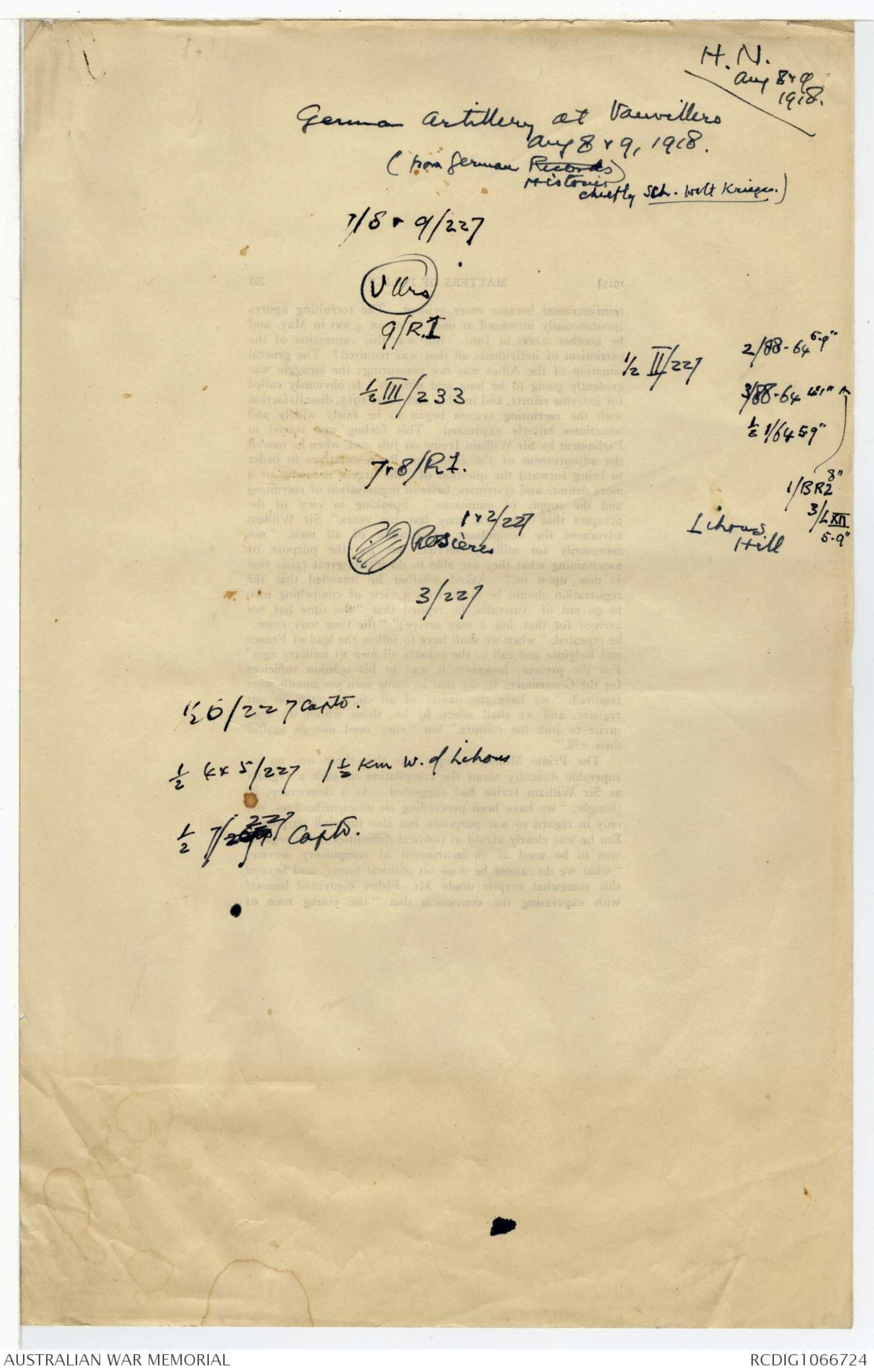
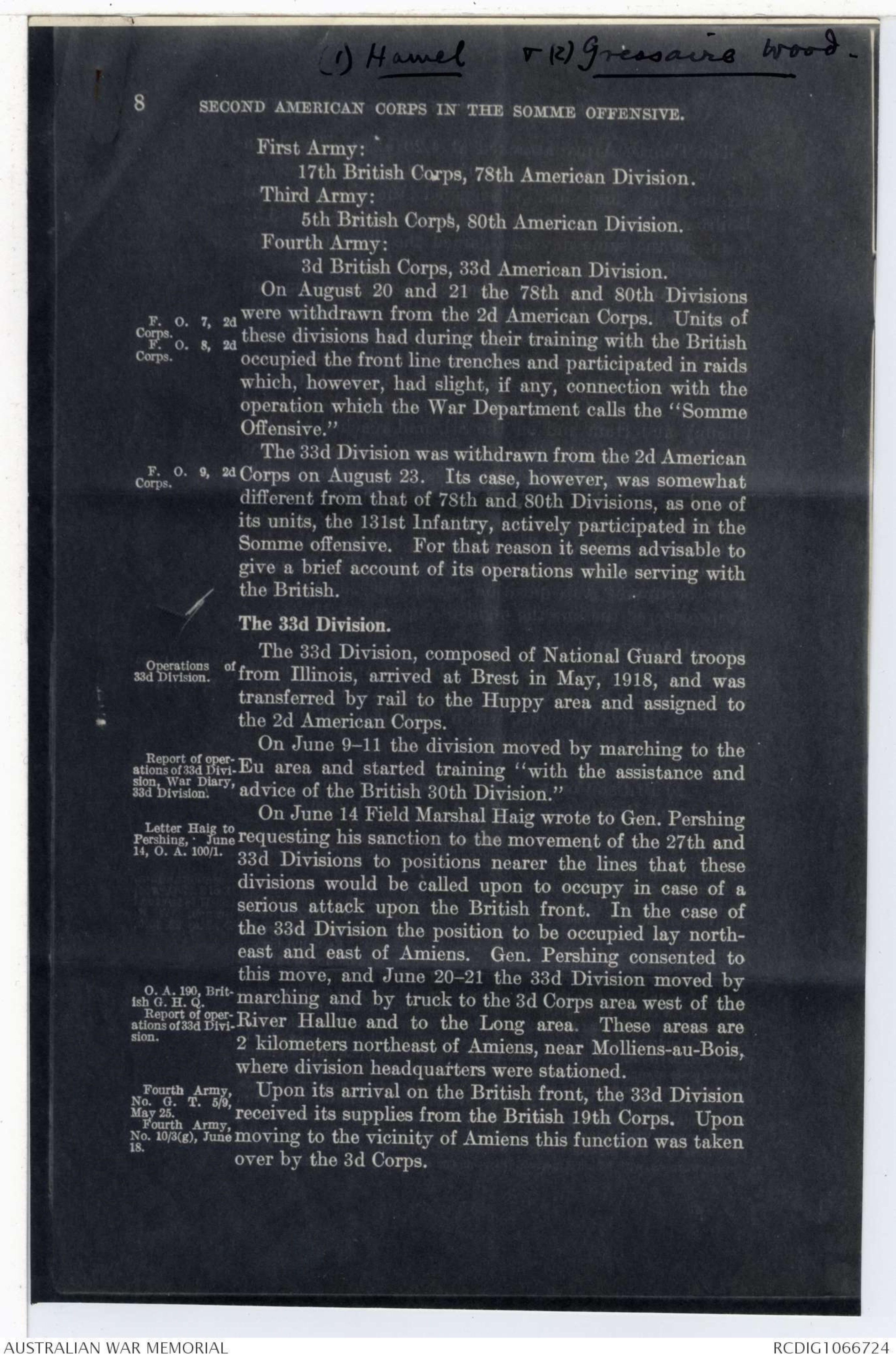
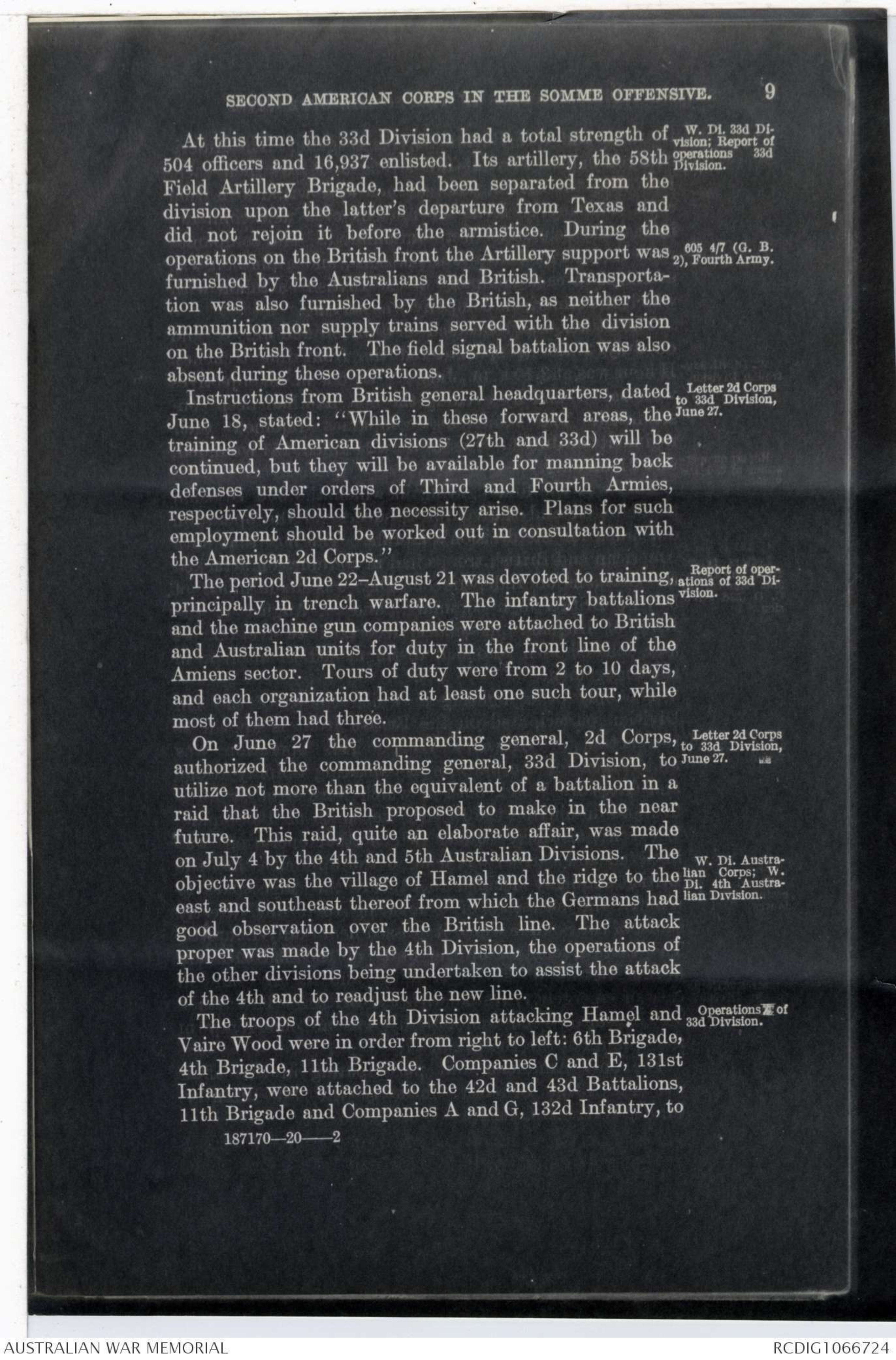
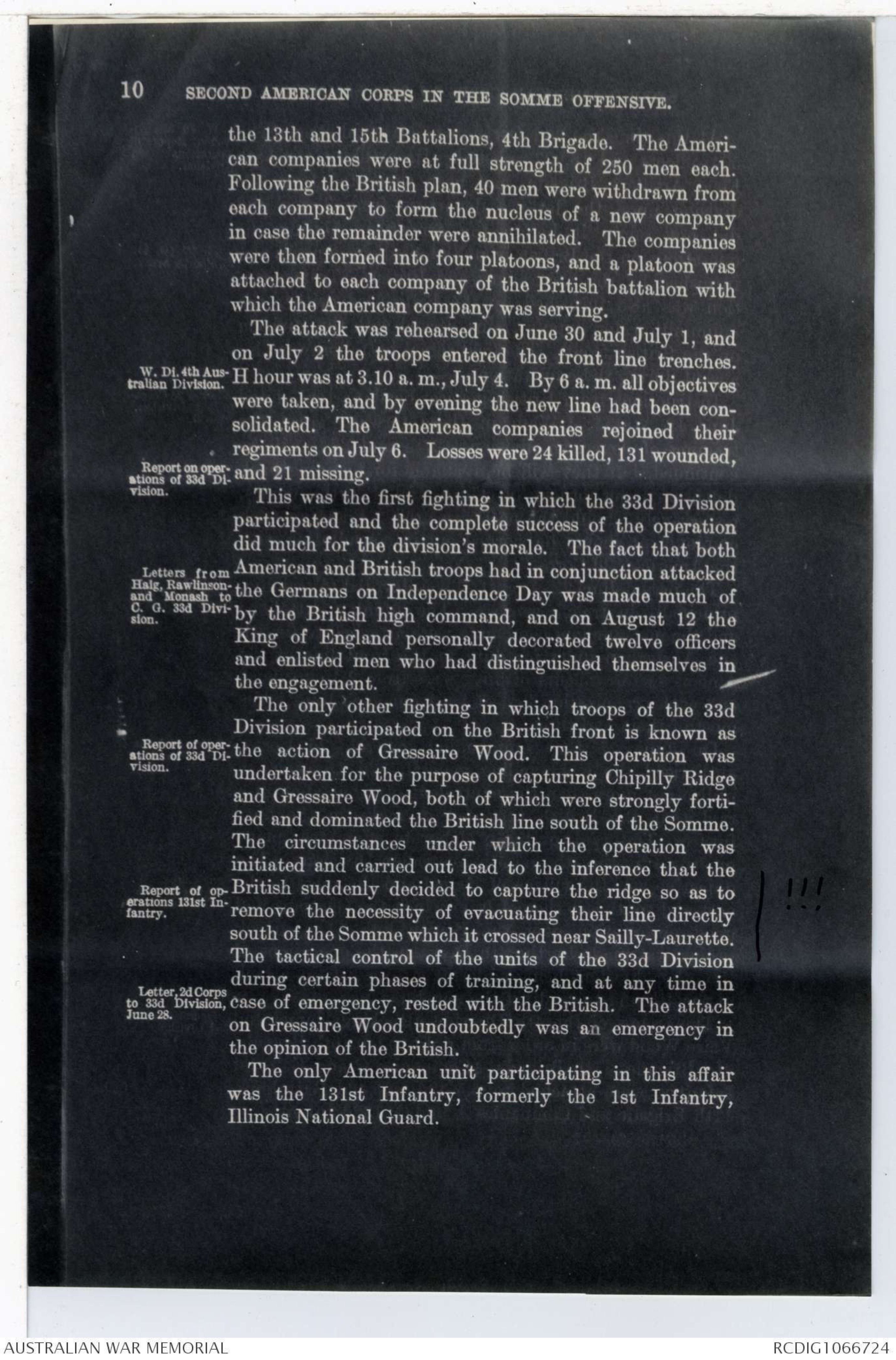
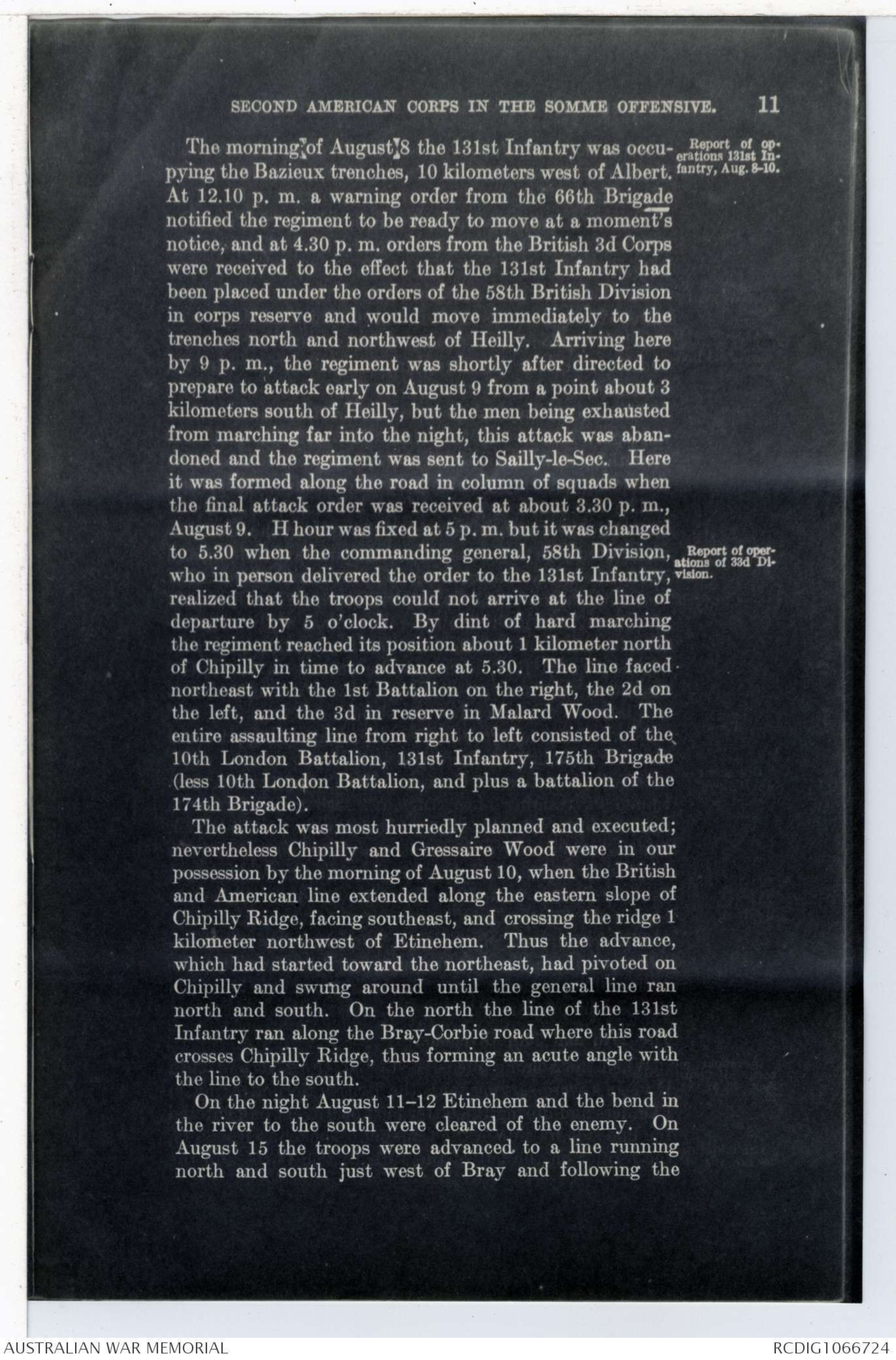
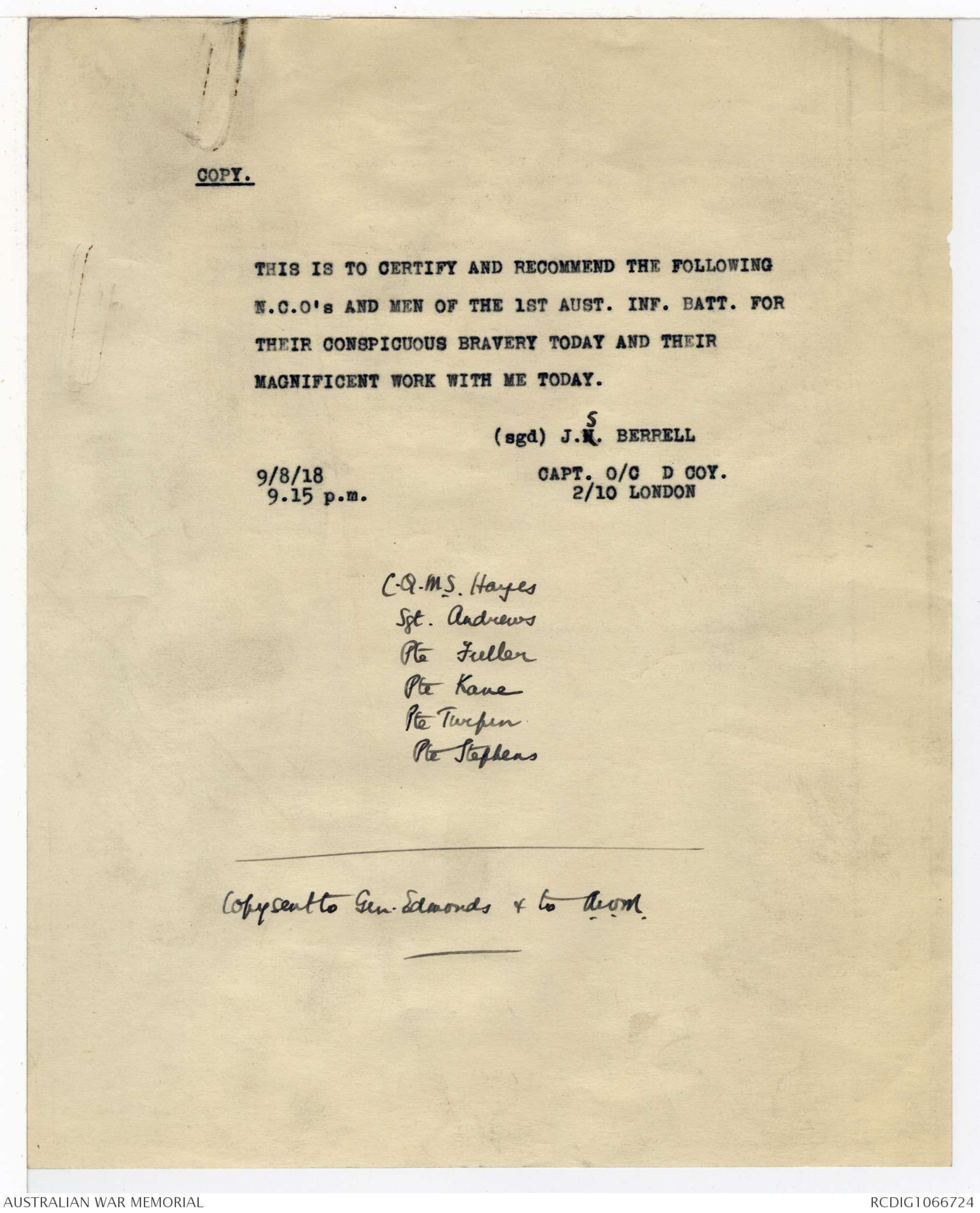
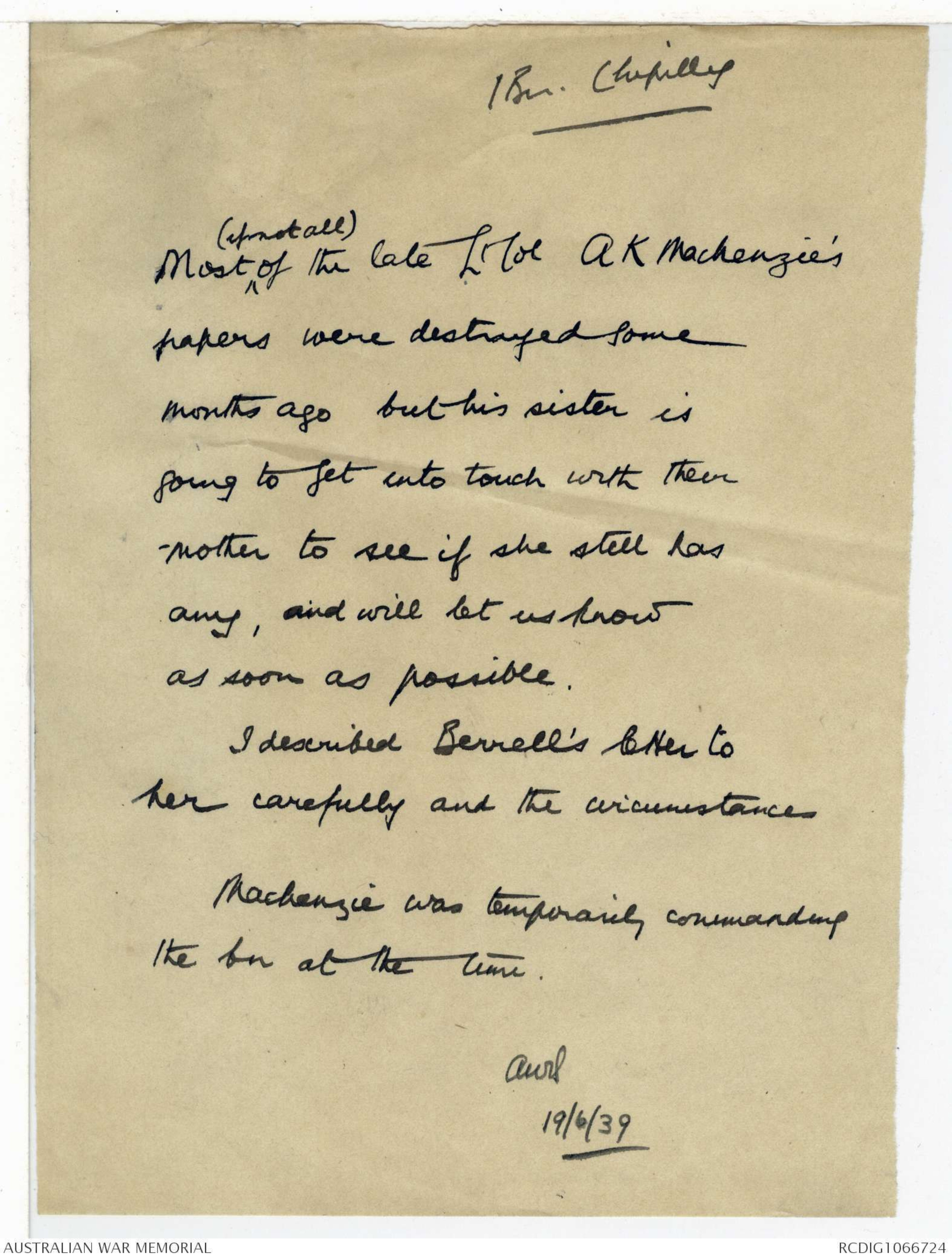

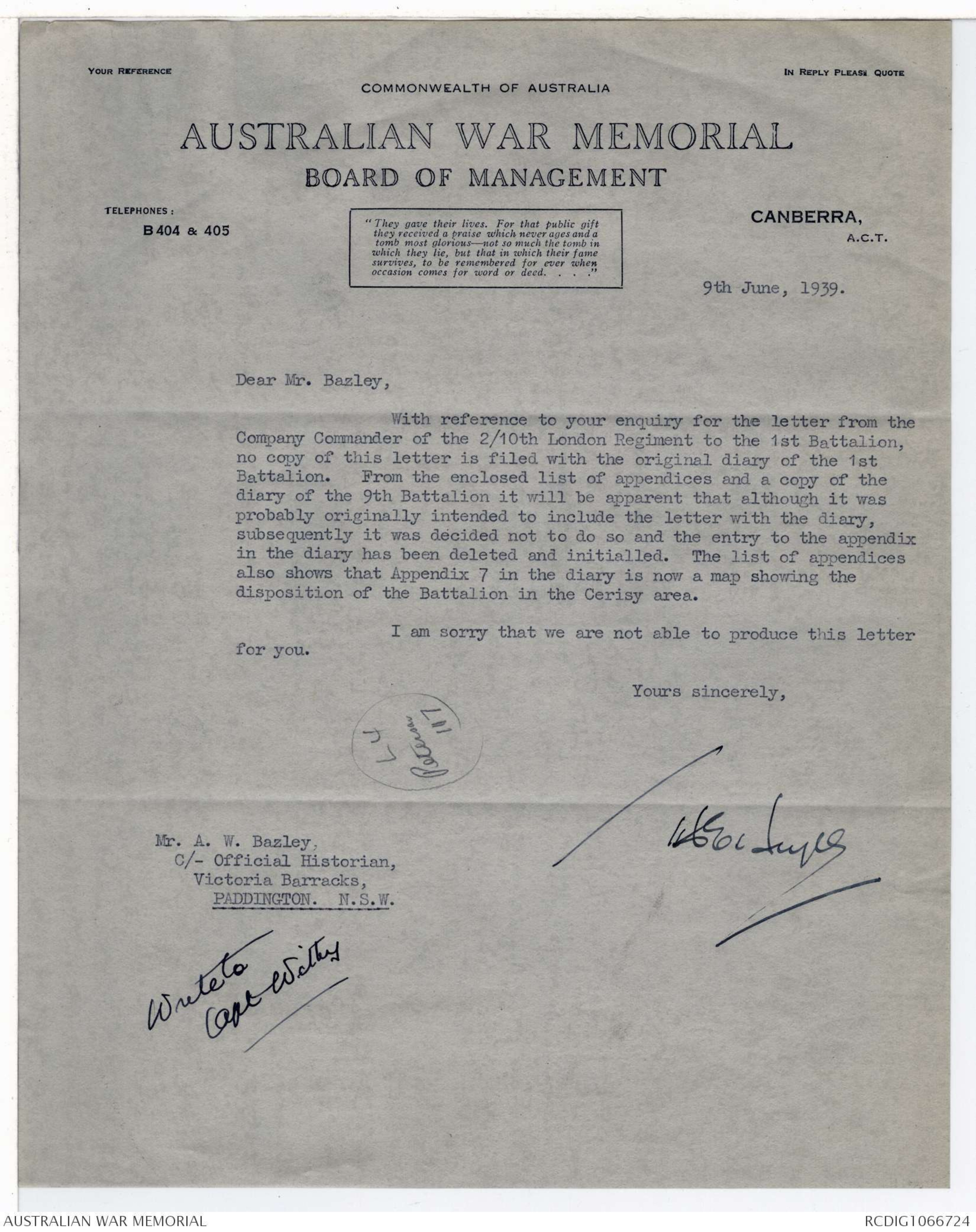
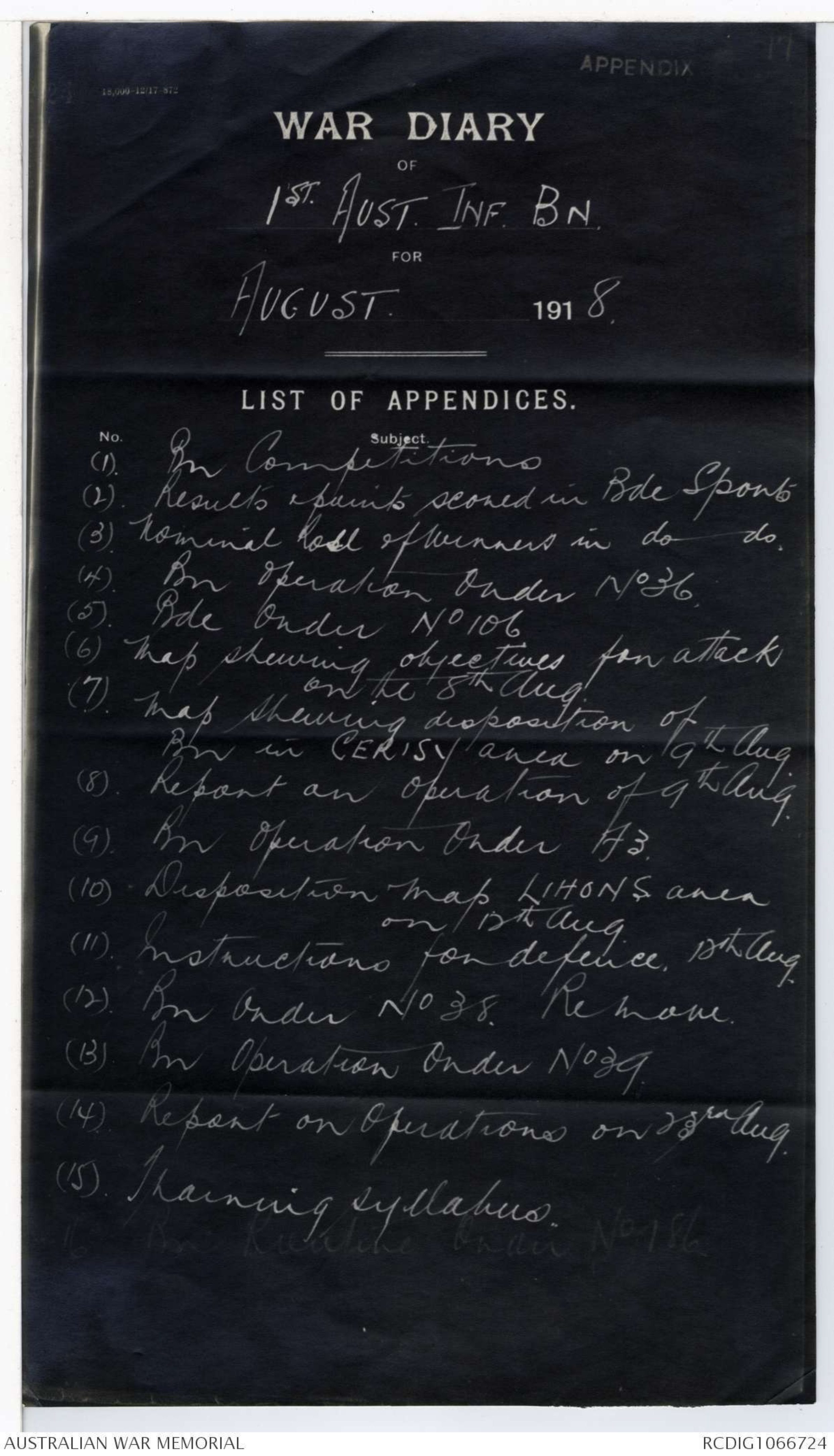
H.N.
Aug 8 & 9
1918
German Artillery at Vauvillers
Aug 8 & 9 , 1918
(from German records histories)
Chiefly Sch. Wilt Krieges)
7/8 & 9/227
Vllrs
9/RI
1/2 III/233
1/2 III/227
2/88-64 6.9"
3/88.64 4.1"
1/3 1/645.9"
1/ BR2 8"
3/ LXII 5.9"
Lihous Hill
7&8/R1
1&2/227
Rosieres
3/2271/2 6/227 Capt
1/2 4x5/227 1 1/2 km w of Lihous
1/2 7/227 Capts.
(1) Hamel & (2) Gressaire Wood
(1) 8 SECOND AMERICAN CORPS IN THE SOMME OFFENSIVE.
First Army:
17th British Corps, 78th American Division.
Third Army:
5th British Corps, 80th American Division.
Fourth Army:
3d British Corps, 33d American Division.
[*F.O.7, 2d Corps. F.O.S, 21 Corps.
On August 20 and 21 the 78th and 80th Divisions
were withdrawn from the 2d American Corps. Units of
these divisions had during their training with the British
occupied the front line trenches and participated in raids
which, however, had slight, if any, connection with the
operation which the War Department called the "Somme
Offensive."
[*F.O.9,2d Corps
The 33rd Division was withdrawn from the 2d
Corps on August 23. Its case, however, was somewhat
different from that of 78th and 80th Divisions, as one of
its units, the 131st Infantry, actively participated in the
Somme Offensive. For that reason it seems advisable to
give a brief account of it's operations while serving with
the British.
The 33d Division
[*Operations of 33d Division
The 33d Division, composed of the National Guard troops
from Illinois, arrived at Brest in May, 1918, and was
transferred by rail to the Huppy area and assigned to
the 2d American Corps.
[* Report of operations of 33d Division, War Diary, 33d Division.
On June 9-11 the Division moved by marching to the
Eu area and started training " with the assistance and
advice of the British 30th Division."
[*Letter Haig to Pershing. June 14, O.A. 100/1
On June 14 Field Marshall Haig wrote to Gen. Pershing
requesting his sanction to the movement of the 27th and
33d Divisions to positions nearer to the lines that these
divisions would be called upon to occupy in case of a
serious attack upon the British front. In the case of
the 33d Division the position to be occupied lay north-east
and east of Amiens. Gen. Pershing consented to
this move, and June 20-21 the 33d Division moved by
marching and by truck to the 3d Corps area west of the
River Hallue and to the Long area. These areas are
2 kilometers northeast of Amiens, near Molliens-au-Bois,
where division headquarters were stationed.
[*O.A. 190, British G.H.Q. Report of operations of 33d Division
[* Fourth Army No. G.HT. 5/9, May 25.
[*Fourth Army No. 10/3(g), June 18.*]
Upon its arrival on the British front, the 33d Division
received its supplies from the British 19th Corps. Upon
moving to the vicinity of Amiens this function was taken
over by the 3d Corps.
SECOND AMERICAN CORPS IN THE SOMME OFFENSIVE 9
[* W. DL 33d Divisions: report of operations 33d Division]
At this time the 33d Division had a total strength of
504 officers and 16,937 enlisted. It's artillery , the 58th
Field Artillery Brigade, had been separated from the
division upon the latter's departure from Texas and
did not rejoin it before the armistice. During the
operations on the British front the Artillery support was
furnished by the Australians and British. Transportation
was also furnished by the British, as neither the
ammunition nor supply trains served with the division
on the British front. The field signal battalion was also
absent during these operations.
[*605 4/7 (G.B.2), Fourth Army,
[*Letter 2d Corps to 33d Division June 27]
Instructions from British general headquarters dated
June 18, stated: " While in these forward areas, the
training of American Divisions ( 27th and 33d) will be
continued, but they will be available for manning back
defenses under orders of Third and Fourth Armies,
respectively, should the necessity arise. Plans for such
employment should be worked out in consultation with
the American 2d Corps. "
[*Report of operations of 33d Division.]
The period June 22-August 21 was devoted to training
principally in trench warfare. The infantry battalions
and the machine gun companies were attached to British
and Australian units for duty in the front line of the
Amiens sector. Tours of duty were from 2 to 10 days,
and each organization had at least one such tour, which
most of them had three.
[*Report of operations of 33d Division.]
On June 27 the commanding general, 2d Corps,
authorized the commanding general, 33d Division, to
utilize not more than the equivalent of a battalion in a
raid that the British proposed to make in the near
future. This raid, quite an elaborate affair, was made
on July 4 by the 4th and 5th Australian Divisions. The
objective was the village of Hamel and the ridge to the
east and southeast thereof from which the Germans had
good observation over the British line. The attack
proper was made by the 4th Division, the operations of
the other divisions being undertaken to assist the attack
of the 4th and to readjust the new line.
[*W.Di. Australian Corp; W DL. 4th Australian Division.
[* Operations of 33d Division]
The troops of the 4th Division attacking Hamel and
Vaire Wood were in order from right to left: 6th Brigade
4th Brigade, 11th Brigade. Companies C and E, 131st
Infantry, were attached to the 42d and 43d Battalions,
11th Brigade and Companies A and G, 132d Infantry, to
187170--20--2
10 SECOND AMERICAN CORPS IN THE SOMME OFFENSIVE
the 13th and 15th Battalions, 4th Brigade. The American
companies were at full strength of 250 men each.
Following the British plan, 40 men were withdrawn from
each company to form the nucleus of a new company
in case the remainder were annihilated. The companies
were then formed into four platoons, and a platoon was
attached to each company of the British battalion with
which the American company was serving.
The attacked was rehearsed on June 30 and July 1, and
on July 2 the troops entered the front line trenches.
[*W. Di. 4th Australian Division]
H hour was at6 3.10 a.m., July 4. By 6 a.m. all objectives
were taken, by evening the new line had been consolidated.
The American companies rejoined their
regiments on July 6. Losses were 24 killed, 131 wounded,
and 21 missing.
[* Report on operations of 33d Division.]
This was the first fighting in which the 33d Division
participated and the complete success of the operation
did much for the division's morale. The fact that both
[*Letters from Haig, Rawlinson and Monash to G. G. 33d Division]
American and British troops had in conjunction attacked
the Germans on Independence day was made much of
by the British high command, and on August 12 the
King of England personally decorated twelve officers
and enlisted men who had distinguished themselves in
the engagement.
The only other fighting in which troops of the 33d
Division participated on the British front is known as
the action of Gressaire Wood. This operation was
undertaken for the purpose of capturing Chipilly Ridge
and Gressaire Wood, both of which were strongly fortified
and dominated the British line south of the Somme.
The circumstances under which the operation was
initiated and carried out lead to the inference that the
British suddenly decided to capture the ridge so as to
[*Report of operations 131st Infantry.]
[!!!]
remove the necessity of evacuating their line directly
south of the Somme which it crossed near Sailly-Laurette.
The tactical control of the units of the 33d Division
during certain phases of training, and at any time in
[*Letter, 2d Corps to 33d Division June 28.]
case of emergency, rested with the British. The attack
on Gressaire Wood undoubtedly was an emergency in
the opinion of the British.
The only American unit participating in this affair
was the 131st Infantry, formerly the 1st Infantry,
Illinois National Guard.
SECOND AMERICAN CORPS IN THE SOMME OFFENSIVE 11
[*Report of operations 131st Infantry, Aug. 8-10.]
The morning of August 8 the 131st Infantry was occupying
the Bazieux trenches, 10 kilometers west of Albert.
At 12.10 p. m. a warning order from the 66th Brigade
notified the regiment to be ready to move at amoment's
notice, and at 4.30 p. m. orders from the British 3d Corps
were received to the effect that the 131st Infantry had
been placed under the orders of the 58th British Division
in corps reserve and would move immediately to the
trenches north and northwest of Heilly. Arriving here
by 9 p. m., the regiment was shortly after directed to
prepare to attack early on August 9 from a point about 3
kilometers south of Heilly, but the men being exhausted
from marching far into the night, this attack was abandoned
and the regiment was sent to Sailly-le-Sec. Here
it was formed along the road in column of squads when
the final attack order was received at about 3.30 p. m.,
August 9. H hour was fixed at 5 p. m. but it was changed
to 5.30 when the commanding general, 58th Division,
[*Report of operations of 33d Division.]
who in person delivered the order to 131st Infantry,
realized that the troops could not arrive at the line of
departure by 5 o'clock. By dint of hard marching
the regiment reached its position about 1 kilometer north
of Chipilly in time to advance at 5.30. The line faced
northeast with the 1st Battalion on the right, the 2d on
the left, and the 3d in reserve in Malard Wood. The
entire assaulting line from right to left consisted of the
10th London Battalion, 131st Infantry, 175th Brigade
(less 10th London Battalion, and plus a battalion of the
174th Brigade).
The attack was most hurriedly planned and executed;
nevertheless Chipilly and Gressaire Wood were in our
possession by the morning of August 10, when the British
and American line extended along the eastern slope of
Chipilly Ridge, facing southeast, and crossing the ridge 1
kilometer northwest of Etinehem. Thus the advance,
which had started towards the northeast had pivoted on
Chipilly and swung around until the general line ran
north and south. On the north the line of the 131st
Infantry ran along the Bray-Corbie road where this road
crosses Chipilly Ridge, thus forming an acute angle with
the line to the south.
On the night of August 11-12 Etinehem and the bend in
the river to the south were cleared of the enemy. On
Au8gust 15 the troops were advanced to a line running
north and south just west of Bray and following the
COPY.
THIS IS TO CERTIFY AND RECOMMEND THE FOLLOWING
N.C.O's AND MEN OF THE IST AUST. INF. BATT. FOR
THEIR CONSPICUOUS BRAVERY TODAY AND THEIR
MAGNIFICENT WORK WITH ME TODAY.
(sgd) J.N. S. BERRELL
9/8/18 CAPT. O/C D COY.
9.15 p. m. 2/10 LONDON
C.Q.MS. Hayes
Sgt. Andrews
Pte Fuller
Pte Kane
Pte Turfen
Pte Stephens
Copy sent to Gen. Edmonds & to [[AIOM?]]
1 Bn. Chipilly
Most ∧(if not all) of the late LtCol AK MacKenzie's
papers were destroyed some
months ago but his sister is
going to get in touch with their
mother to see if she still has
any, and will let us know
as soon as possible.
I described Berrell's letter to
her carefully and the circumstances
MacKenzie was temporarily commanding
the bn at the time.
[[AURL?]]
19/6/39
[*Rang
Boardman:
He does not
know where
letter or a
copy of it might be.
Major MacKenzie
was OC of bn at
time. He might
have kept it.
MacKenzie is
dead, so is
his wife.
Try & get
touch with Col
Stacy.]
c/- Eagers Retail Pty Ltd.,
Primary Bldg.
cnr. Creek & Adelaide Streets
Brisbane.
June 16th 1939.
C.E.W. Bean, Esq.,
Official Historian
Victoria Barracks,
PADDINGTON.
Sydney.
N.S.W
Ref. No. 11303.
Dear Sir,
I am in receipt of your letter of the 14th June asking
me if I had any knowledge of the whereabouts of a letter written by a
Company Commander of the 2/10th London Regiment, in appreciation of the
work done by a lst Battalion Patrol led by C.Q.M.S. Hayes at Chipilly
in August 1918.
I regret that I cannot be of much help in this matter
as I have not got a copy of the letter in question. In all probability
it was sent forward with the recommendation for C.Q.M.S. Hayes' decoration,
but probably Lieut. H.H. Boardman, of 37, Vauclause Rd., Vauclause, may
be able to give you some further information, as he was I think our
Adjutant at that particular period.
I am glad to know that the matter of the Chipilly patrol
is under the consideration of the Official Historian, as it was a
particularly good Show and a very creditable performance by C.Q.M.S.Hayes
and the few lads that went with him. At this particular time I was
commanding 'C' Company and found that my Quartermaster-Sergeant was a
very definite contradiction to the general conception of a Quarter-Master-
Sergeant, insomuch that on every possible occasion he took over the C.S.M.
job when it came to front line work, and it was in the capacity of C.S.M.
that he led the Chipilly patrol.
Yours faithfully
[[Signed]]
A B Withy. (Major.)
YOUR REFERENCE
IN REPLY PLEASH QUOTE
COMMONWEALTH OF AUSTRALIA
AUSTRALIAN WAR MEMORLAL
BOARD OF MANAGEMENT
TELEPHONES: CANBERRA,
B404 & 405 A.C.T
"They gave their lives. For that public gift
they received a praise which never ages and a
tomb most glorious – not so much the tomb in
which they lie, but that in which their fame
survives, to be remembered for ever when
occasion comes for word or deed..."
9th June, 1939.
Dear Mr. Bazley,
With reference to your enquiry for the letter from the
Company Commander of the 2/10th London Regiment to the 1st Battalion,
no copy of this letter is filed with the original diary of the 1st
Battalion. From the enclosed list of appendices and a copy of the
diary of the 9th Battalion it will be apparent that although it was
probably originally intended to include the letter with the diary,
subsequently it was decided not to do so and the entry to the appendix
in the diary has been deleted and initialled. The list of appendices
also shows that Appendix 7 in the diary is now a map showing the
disposition of the Battalion in the Cerisy area.
I am sorry that we are not able to produce this letter
for you.
[*L4
Peterson
107]
Yours sincerely,
Mr. A. W. Bazley
C/- Official Historian,
Victoria Barracks,
PADDINCTON. N.S.W.
[*Write to
Capt Withy]
APPENDIX 17
WAR DIARY
OF
1st AUST. INF. BN
FOR
AUGUST 1918
LIST OF APPENDICES.
No Subject
(1) Bn Competitions
(2) Results & points scored in Bde Sports
(3) Nominal Roll of Winners in do do
(4) Bn Operation Order No36
(5) Bde Order No 106
(6) Map showing objectives for attack
on the 8th August
(7) Map showing disposition of
Bn in CERISY area on 9th Aug.
(8)Report on operation of 9th Aug.
(9) Bn Operation Order A3
(10) Disposition map LIHONS area
on 12th Aug.
(11) Instructions for defence. 12th Aug.
(12) Bn Order No 38. Remove.
(13) Bn Operation Order No 39.
(14) Report on Operations on 23rd Aug.
(15) Training Syllabus.
 Sam scott
Sam scottThis transcription item is now locked to you for editing. To release the lock either Save your changes or Cancel.
This lock will be automatically released after 60 minutes of inactivity.